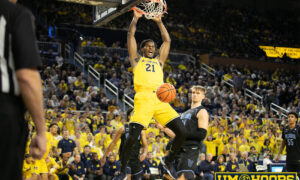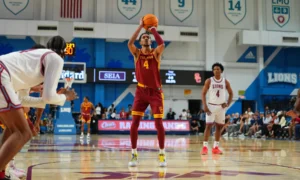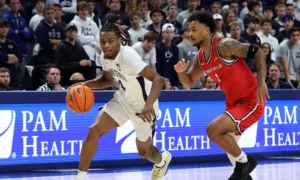Twelve games into the season, Michigan has surpassed almost every offensive expectation. The Wolverines are ranked 19th in the country in adjusted offensive efficiency, 29 spots ahead of where they finished last year despite losing Hunter Dickinson, Jett Howard, and Kobe Bufkin from the rotation.
With roughly a third of the season in the books, it is the perfect time to take a step back and look at Michigan’s offensive personnel, how they’ve improved since last year, what actions they prefer, and where they are most effective.
Dug McDaniel

- Dug McDaniel has emerged as one of the elite playmakers in the country, and he’s putting up impressive statistics — 19.2 points and five assists per game — as the only true perimeter playmaker on Michigan’s roster. McDaniel has also maintained exceptional efficiency despite the usage and pressure on him to power Michigan’s offense.
- He’s ranked 2nd in the country with 19.7 points per game created out of ball screen shots and passes. Despite being one of the highest-usage ball screen players in the country, he’s scoring 1.03 points per play (87th percentile).
- With some notables labeled, this plot of every ball screen player in the country helps illustrate just how effective McDaniel has been in ball screen situations compared to the rest of the country and the extent to which Michigan relies on him to power the offense.

- McDaniel’s most obvious improvement this season has been at the rim. He’s getting to the rim a bit more often — 21% of attempts compared to 18% last year — but mostly, he’s finishing despite his diminutive frame. McDaniel is shooting 58% on shots at the rim, up from 32% last year.
- McDaniel’s collection of floaters, runners, and in-between finishes have always been a staple of his game. He was effective with that shot last year (44%) and has continued on a similar trajectory this year at 49%. Only two players in the country score more points per game off of runners and floaters (Boo Buie and Detroits’ Marcus Tankersley). McDaniel’s shot chart shows he’s improved finishing with that short runner on the left side of the floor this year.
- The more subtle and potentially most important shift in McDaniel’s game has been his shot selection. A year ago, he took a lot of pull-up jumpers from the elbow. This year, he’s taking those shots behind the 3-pointer line. McDaniel’s effective field goal percentage on off-the-dribble jumpers is up to 52.8%. A year ago, 41% of his pull-up jumpers were from 3-point range. This year, 72% of his pull-up jumpers are from 3-point range. He made 20 3-pointers off the bounce last year and is already up to 15 this season.
- McDaniel rarely plays without the ball, but he’s shooting 37% on catch-and-shoot threes, up from 29.5% last year.
- McDaniel’s assist-to-turnover ratio in transition has also improved. It is up 6.7 to 1 this year, compared to 2 to 1 as a freshman.
Happy Holidays from UM Hoops!
This article is unlocked for all to read over the holidays, but if you want more great Michigan basketball coverage and analysis, join our community today!
Olivier Nkamhoua

- Olivier Nkamhoua came to Michigan in part to play a different role in a different offense. The move has mostly paid off. He’s playing more (81% of minutes, up from 62.8% at Tennessee), and he’s also playing more on the perimeter.
- A third of his possessions at Tennessee were post-ups, compared to 19% this year. He’s also getting fewer touches as a cutter (10% of his offense, down from 21%). Meanwhile, he’s up to 26% of his possessions out of spot-ups, up from 15% last year. Nkamhoua is getting more touches on the wing and outside the 3-point line than he ever did at Tennessee. That shift is at the root of Nkamhoua’s evolution as a player, for better and worse.
- Nkamhoua is taking more catch-and-shoot attempts per game — 3.3, up from 1.7 — and he’s improved his accuracy: 56.4 eFG%, up from 50.8.
- He’s been very efficient as a shot creator, scoring 1.11 points per play in post-up or isolation situations. According to Syenrgy’s Shot Quality stats, Nkamhoua scores .18 points over expected per post-up shot and .61 points over expected per isolation shot. He takes and makes tough shots consistently for an offense that needs a secondary shot creator. Nkamhoua’s sweet spot is still that 10-foot range with the turnaround jumper.
- In the post, Nkamhoua has been more efficient going over his left shoulder (1.23 PPP) than his right shoulder (.714 PPP) but goes to the right more often. He was more balanced but more proficient over his right shoulder a year ago.
- Nkamhoua is still an elite finisher at the rim, shooting just under 70%, and averages over a dunk per game.
- The transition to a more perimeter-oriented role has brought up some trouble spots. Mostly, Nkamhoua struggles to drive the ball off the bounce. He almost always drives to his right (16 of 22 spot-up drives, 68% of all drives) and scores just .69 points per play when he drives out of spot-up situations, shooting 46% and turning it over on a quarter of his possessions. Those “catch-and-attack” wing touches are the biggest pain point in Nkamhoua’s game right now.
- Despite those struggles, Nkamkhoua is ranked 14th in the country in shot-making over expectations among all “playmaking bigs,” per Synergy.
Nimari Burnett

- Nimari Burnett has already played 387 minutes this year, which is close to matching his career high for total minutes played set last season at 392. That illustrates how much Michigan is asking of Burnett relative to his career and how little we knew about his game before he arrived in Ann Arbor.
- The most interesting takeaway from Burnett’s profile up to this point is that he has inverse jump-shooting splits. Burnett is a more accurate shooter off the dribble (43%, 55 eFG%, 30 attempts) than off the catch (34%, 50 eFG%, 44 attempts). That’s atypical for most players, especially non-point guards.
- My best guess for the inverse splits is how Burnett loads up for his release. He doesn’t have the quickest release and seems to be bothered on closely contested catch and shoots (27%), but he is more comfortable if he can take one dribble and get into his jumper more naturally.
- The elephant in the room is the finishing. Burnett wasn’t a great finisher at Alabama, and he’s struggled at Michigan. Burnett is shooting 44% at the rim, 33% on layups (21 attempts), and is 1-of-4 on runners.
- The short 10-to-15-foot jumper has been his most reliable 2-point shot, almost all on the right side of the floor.
- I don’t usually read too much into sidedness on a shot chart when it comes to efficiency, because of the small samples early in the season, but this is the second year in a row that Burnett has shot it much better from the right side of the floor than the left.
Terrance Williams II

- Terrance Williams II is in the midst of one of the most impressive perimeter shooting turnarounds I can remember from a Big Ten player. Williams was a career 28% 3-point shooter entering the year and is knocking down 42% of his threes on over five attempts per game.
- It’s not just that Williams is making threes; it’s that he’s more efficient and more aggressive than anyone would have imagined. He’s leading the Big Ten in points per game scored off of catch-and-shoot shot attempts at 6.8 per game. Williams isn’t just having a bounceback shooting year; he’s legitimately been one of the best perimeter shooters in the Big Ten.

- Williams is shooting 43.8% on catch-and-shoot attempts (63.3 eFG%), a significant increase from 28.4% (39.9 eFG%) last year. He’s also shooting 46% on transition threes, which is impressive considering he’s attempted his fair share of heat checks this season.
- Williams has already made 28 catch-and-shoot threes this year after hitting 21 all last season.
- The transition to playing the three instead of the four has led to some uptick in other actions. Mainly, Michigan is running Williams off of a few screens to get him open for jumpers or right-handed drives to the rim. He’s just 4-of-12 on shots off of screens, but at 14 possessions, he’s getting a little more than one play per game. A year ago, he took four shots off of screens the entire season.
- He’s not doing much playmaking or shot creation from the wing. He’s only logged six possessions total of ball screen or isolation plays, one post-up, and five dribble handoffs.
Tarris Reed Jr.

- Tarris Reed Jr.’s sophomore year has been a bit of an adventure, but he’s shown real progress over the last two weeks. He’s averaging 15.3 points per game over Michigan’s last three games after reaching double figures in only one of its first nine games.
- Around a quarter of Reed’s offensive plays are post-ups, and he’s 8-of-16 from the floor on those actions. That’s a decent shooting percentage on post-ups, but it hides the whole story. Reed turns it over on 30% of post-up plays and has struggled at the free-throw line. Both flaws hold back his efficiency, and he averages just .633 points per post-up play, 17th percentile.
- Reed’s inefficiency as a cutter and roller is the more significant concern. He’s scoring .941 points per play as a cutter (17th percentile) and .93 points per play as a roller (36th percentile). Shooting 50% or worse on these attempts is tough because these are supposed to be some of the most efficient touches in Michigan’s offense. On the year, Reed has a -.35 points per shot “shot-making score” on cuts and a -.10 “shot-making score” on rolls.
- Reed’s face-up and isolation game has been a sneakily efficient part of his arsenal. He’s scored 11 points on six isolation possessions.
Will Tschetter

- Tschetter hasn’t taken many shots this year, but he’s made most of them. He’s shooting 75% on twos and 67% on threes (18 attempts) for an 84 eFG% that would sound high in a one-game sample, let alone 12.
- Tschetter is scoring .59 points per shot over expected on his attempts for the year.
- He’s 7 of 12 on catch-and-shoot jumpers (94.7 eFG%) and shooting 75% at the rim on 28 attempts.
- Tschetter also leads Michigan in scoring as a roller/popper with 17 points on 14 possessions, including 12 points on nine pick-and-pops. That’s an interesting stat for two reasons. First, it shows how efficient Tschetter has been in those spots, but also that Michigan isn’t getting many touches for Reed (15) or Nkamhoua (4) as a screener.
Tray Jackson

- Tray Jackson played most of his minutes at the five for Seton Hall last year and is seeing more time at the three and four this year. The transition hasn’t been smooth.
- A couple of issues are plaguing Jackson, but his jumper is one notable concern. Jackson has only attempted 16 catch-and-shoot jumpers and made 19% of them. A year ago, he shot 34% on catch-and-shoot jumpers; the year before that, he shot 38%. That season two years ago, when Jackson played more of a stretch four, 51% of his attempts were catch-and-shoot jumpers. This year, only 28% of his attempts are catch-and-shoot jumpers.
- Jackson plays most of his minutes behind Williams, who has been thriving on catch-and-shoot looks in the same role, illustrating the extent to which Jackson’s jumper is holding him back. Both in his willingness to take threes, and his ability to make them.
- Jackson’s stats on drives demonstrate some of his pros and cons this season. He’s 8-of-9 from the floor when he drives to the basket. That’s remarkably efficient, but he’s turned it over on 36% of the possessions he tries to drive to the basket. In short, every drive is either a bucket or a turnover.
- His transition stats have also seen significant regression. He grades out in the 18th percentile as a transition scorer, 5 of 12 from the floor, with a 20% turnover rate. He was in the 94th percentile in transition two years ago and the 81st percentile last year.
- He is efficient around the rim and has done an excellent job of finishing cuts and putbacks.

Notable Replies
Discuss the Article
57 more replies









Champions
Title should reflect that this is a self scout of the offense.
mgl
Obviously we all know generally how the guys have been doing, but placing them contextually within the national picture really underscored lots of things to me. Terrance Williams → actual weapon behind the arc! Dug carrying massive usage and efficiency!
The one thing that caught my eye, and it may be nothing, is that Dug’s jumpshooting flipped sides year over year? Generally players “like” one side of the floor more than the other.
As alluded above, I’d love to see this for defense. But to a comment you made earlier - it’s pretty startling our offense has been this good with this personel, and while our defense has made some of the offensive over-performance moot, it’s interesting to see how/why they’re driving the things they’re doing well.
One question: how does Reed’s turnover rate compare to similar players?
Second question: do you see any mechanical difference in Will’s jump-shot that’s driving better results? Obviously, he’s currently way over his head in terms of %, but do you think he’s genuinely improved, or is this just poor results last year/good results this year redounding to “he’s a perfectly fine shooter”.
umhoops
Made it pretty clear in the first paragraph that it was about offense. Sorry for the poor headline! Happy Holidays!
umhoops
I wouldn’t read into that. The difference between 41% and 37% is basically nothing when you are talking about shooting in a zone. Add to that, he takes a ton of shots in the middle of the floor which is probably more of a 50-50 proposition of which “side” they end up on because of how I make the chart.
I think the big shift is that he isn’t dribbling into those pull-ups right inside the arc, usually to his right hand, and is getting to more threes.
Not sure what would be a similar player. His efficiency is in the teens percentile wise, so that’s pretty much how he compares to others. Obviously that includes FG%, TOs, FTs, etc.
Among players with 25 post-ups, looks like Reed’s 30% turnover rate is the 3rd highest in CBB.
Olivier turns it over on 8% of his post-ups, for example.
Not really equipped to analyze mechanics, to be honest. I mean, he’s clearly not a 75% 3-point shooter or whatever, but I always expected him to make shots eventually. Shooting is a big part of what he does.
If anything, I have a hard time figuring out why he isn’t a better free-throw shooter.
Yeah, would obviously have to be a what’s wrong with Michigan’s defense type of thing. I just never really think of defense on an individual level like that. And there’s no worthwhile way to measure defense analytically, so the post would be a completely different style.
If I see one more person reference someone’s “Synergy defensive grade” without noting that it is a bad start in the first place and that the person who guard’s the other team’s best player is probably going to allow more points per possession I might lose my mind.
mgl
Yeah, I know that it’s not really possible to numerically evaluate an individual’s defense. Just more things like “the main issue is rebounding” or “we can’t stop dribble penetration” or “we don’t make any affirmative plays” (lol it’s probably all of those)